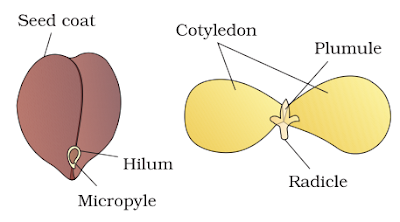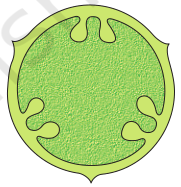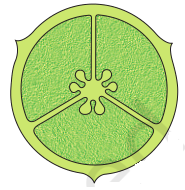NCERT Solutions for Class 11th: Ch 5 Morphology of Flowering Plants Biology
Page No: 82
Exercises
1. What is meant by modification of root? What type of modification of root is found in the
(a) Banyan tree
(b) Turnip
(a) Banyan tree
(b) Turnip
(c) Mangrove trees
Answer
The primary function of the root is absorption of water and minerals and giving mechanical support to the plant. Sometimes roots get modified to carry out other functions like storage of food or additional mechanical support.
(a) Banyan Tree: In banyan trees long roots develop from branches and they go deep down to reach the ground. They are for providing additional mechanical support to the huge banyan tree. This modification is called as prop root.
(b) Turnip: In turnip the root is modified to store extra food.
(c) Mangrove trees: Mangrove trees are found in marshy area. The roots get modified into pneumatic structures providing extra passage to allow additional oxygen to the plant.
2. Justify the following statements on the basis of external features
(i) Underground parts of a plant are not always roots
(ii) Flower is a modified shoot
Answer
(i) In some plants stems remain underground to carry out some additional functions, like food storage and vegetative reproduction. For example, potatoes are modified form of underground stems.
(ii) When the stem takes on the role of sexual reproduction it is modified into a flower. That is why flower id often called a modified shoot.
3. How is pinnately compound leaf different from palmately compound leaf?
Answer
In pinnately compound leaf a number of leaflets are attached on a common axis. Example, neem leaves while in palmately compound leaf number of leaflets are attached at the common point on the leaf stalk. Example, cotton leaves.
4. Explain with suitable examples the different types of phyllotaxy?
Answer
Phyllotaxy is the pattern of arrangement of leaves on the stem or branch. It is of three types: alternate, opposite and whorled.
• Alternate Arrangement of Leaves: In alternate type of phyllotaxy, a single leaf arises at each node in alternate manner, as in china rose, mustard and sun flower plants.
• Opposite Arrangement of Leaves: In opposite type, a pair of leaves arise at each node and lie opposite to each other as in Calotropis and guava plants.
• Whorled Arrangement of Leaves: If more than two leaves arise at a node and form a whorl, it is called whorled, as in Alstonia.
Page No: 83
5. Define the following terms:
(a) Aestivation
(b) Placentation
(c) Actinomorphic
(d) Zygomorphic
(e) Superior ovary
(f) Perigynous flower
(g) Epipetalous Stamen
Answer
(a) The mode of arrangement of sepals or petals in floral bud with respect to the other members of the same whorl is known as aestivation. The main types of aestivation are valvate, twisted, imbricate and vexillary.
(b) The arrangement of ovules within the ovary is known as placentation. The placentation are of different types namely, marginal, axile, parietal, basal, central and free central.
(c) When a flower can be divided into two equal radial halves in any radial plane passing through the centre, it is said to be actinomorphic, Example: mustard and chilli.
(d) When a flower can be divided into two similar halves only in one particular vertical plane, it is zygomorphic. Example: pea, gulmohur, bean and Cassia.
(e) Superior ovary flowers are those flowers in which the gynoecium is present at the highest position, while other floral parts are arranged below it. A flower with this arrangement is described as hypogynous. Example: brinjal and mustard.
(f) In perigynous flowers, the gynoecium is present in the centre and the rest of the floral parts are arranged at the rim of the thalamus at the same level. Example: plum and rose.
(g) When stamens are attached to the petals, they are epipetalous as in brinjal.
6. Differentiate between
(a) Racemose and cymose inflorescence
(b) Fibrous roots and adventitious roots
(c) Apocarpous and syncarpous ovary
Answer
(a)
Racemose inflorescence
|
Cymose inflorescence
|
| → Younger flowers are present at the tip while older flowers are
arranged at the base of this inflorescence. Such an arrangement is
called acropetal succession. → The main axis in racemose inflorescence continues to grow and produce flowers laterally. |
→ Younger flowers are present at the base of the inflorescence,
while older flowers are present at the top. Such an arrangement is
called basipetal succession. → The main axis in cymose inflorescence has limited growth, which later terminates into a flower. |
(b)
Fibrous root
|
Adventitious root
|
| → In monocots, the primary root which develops from the radicle
of the seed is short-lived and is replaced by a large number of
roots arising from the base of the stem. → It is found in wheat and other cereals. |
→ These roots arise from any part of the plant other than the
radicle of seeds. → It is found in banyan, Monstera, and other plants. |
(c)
Apocarpous ovary
|
Syncarpous ovary
|
| → The flowers with apocarpus ovary have more than one carpel.
These carpels are free. → It is found in lotus and rose flowers. |
→ The flowers with syncarpous ovary have more than one carpel.
However, these carpels are fused. → It is found in the flowers of tomato and mustard. |
7. Draw the labelled diagram of the following:
(i) Gram seed
(ii) V.S. of maize seed
Answer
(a)
(b)
Answer
The modifications of Stem with suitable examples are:
→ Food Storage: Stems are modified to perform different functions. Underground stems of potato, ginger, turmeric, zaminkand, Colocasia are modified to store food in them. They also act as organs of perennation to tide over conditions unfavourable for growth.
Tendrils: Stem tendrils which develop from axillary buds, are slender and spirally coiled and help plants to climb such as in gourds (cucumber, pumpkins, watermelon) and grapevines.
→ Thorns: Axillary buds of stems may also get modified into woody, straight and pointed thorns. Thorns are found in many plants such as Citrus, Bougainvillea. They protect plants from browsing animals. Some plants of arid regions modify their stems into flattened (Opuntia), or fleshycylindrical (Euphorbia) structures. They contain chlorophyll and carry out photosynthesis.
→ Vegetative Reproduction: Underground stems of some plants such as grass and strawberry, etc., spread to new niches and when older parts die new plants are formed. In plants like mint and jasmine a slender lateral branch arises from the base of the main axis and after growing aerially for some time arch downwards to touch the ground. A lateral branch with short internodes and each node bearing a rosette of leaves and a tuft of roots is found in aquatic plants like Pistia and Eichhornia. In banana, pineapple and Chrysanthemum, the lateral branches originate from the basal and underground portion of the main stem, grow horizontally beneath the soil and then come out obliquely upward giving rise to leafy shoots.
9. Take one flower each of families Fabaceae and Solanaceae and write its semi-technical description. Also draw their floral diagrams after studying them.
Answer
→ Family Fabaceae (Pea)
Fabaceae (earlier called Papilionaceae) is a sub-family of the Leguminoseae family.
• Vegetative features:
Habit: Pinnately compound, alternately arranged with leaf tendrils with the pulvinus present at the leaf base along folacious stipules.
Root: Tap root system with root nodules.
• Floral features:
Inflorescence: Racemose, generally axial than terminal
Flower: Zygomorphic and bisexual flowers are found
Calyx: It contains five sepals which are gamosepalous while aestivation is imbricate.
Corolla: It contains five petals (polypetalous) with vexillary aestivation.
Androecium: It consists of ten anthers that are diadelphous with dithecous anthers.
Gynoecium: Monocarpellary superior ovary which is unilocular with marginal placentation.
Fruit: Legume pod with non-endospermic seeds
Family Solanaceae• Vegetative features:
Habit: Pinnately compound, alternately arranged with leaf tendrils with the pulvinus present at the leaf base along folacious stipules.
Root: Tap root system with root nodules.
• Floral features:
Inflorescence: Racemose, generally axial than terminal
Flower: Zygomorphic and bisexual flowers are found
Calyx: It contains five sepals which are gamosepalous while aestivation is imbricate.
Corolla: It contains five petals (polypetalous) with vexillary aestivation.
Androecium: It consists of ten anthers that are diadelphous with dithecous anthers.
Gynoecium: Monocarpellary superior ovary which is unilocular with marginal placentation.
Fruit: Legume pod with non-endospermic seeds
• Vegetative features:
Habit: Erect, herbaceous plant
Leaves: Simple, exstipulate leaves with reticulate venation
Stem: Erect stem with numerous branches.
• Floral features:
Inflorescence: Solitary and axillary
Flowers: Actinomorphic, bisexual flowers
Calyx: Calyx is composed of five sepals that are united and persistent. Aestivation is valvate.
Corolla: Corolla consists of five united petals with valvate aestivation.
Androecium: It consists of five epipetalous stamens.
Gynoecium: It consists of bicarpellary syncarpous superior ovary with axile placentation.
Fruits: Berry
Seeds: Numerous, endospermous
Floral formula:

Economic importance: Used for medicinal purposes.
10. Describe the various types of placentations found in flowering plants.
Answer
Placentation: The arrangement of ovules within the ovary is known as placentation. The placentation are of different types namely, marginal, axile, parietal, basal, central and free central.
The various types of placentations found in flowering plants are:→ Marginal placentation: The ovary in which the placenta forms a ridge along the ventral suture of the ovary and the ovules develop on two separate rows is known to have marginal placentation. This type of placentation is found in peas.
→ Parietal placentation: When the ovules develop on the inner walls of the ovary, the ovary is said to have parietal placentation.
→ Axile placentation: In axile placentation, the placenta is axial and ovules are attached to it. Examples include China rose, lemon, and tomato.
→ Basal placentation: The ovary in which the placenta develops from its base and a single ovule is found attached to the base is said to have basal placentation. It is found in marigold and sunflower.
→ Free central placentation: In free central placentation, the ovules develop on the central axis while the septa are absent. This type of placentation is found in Dianthus and primrose.
11. What is a flower? Describe the parts of a typical angiosperm flower?
Answer
The flower is the reproductive unit in the angiosperms. It is meant for sexual reproduction. A flower has four different parts i.e., the calyx, corolla, androecium, and gynoecium. Androecium and gynoecium represent the male and female reproductive organs of a flower respectively. Parts of flower are:
→ The calyx: The calyx is the outermost whorl of the flower and the members are called sepals. Generally, sepals are green, leaf like and protect the flower in the bud stage. When the sepals of a flower are free, they are called polysepalous, while fused sepals of a flower are called gamosepalous.
→ Corolla: Corolla is composed of petals. Petals are usually brightly coloured to attract insects for pollination. When the petals are free, they are called polypetalous, while fused petals are called gamopetalous. Corolla may be tubular, bell-shaped, funnel-shaped or wheel-shaped.
→ The androecium or the stamen is the male reproductive part of a flower. It consists of two parts, the filament and the bilobed anther. The bilobed anther is the site for meiosis and the generation of pollen grains.
→ Gynoecium represents the female reproductive part of a flower. It consists of an ovary. The ovary is connected by a long tube (called style) to the stigma. The ovary bears numerous ovules attached to the placenta.
12. How do the various leaf modifications help plants?
Answer
Leaves are often modified to perform functions other than photosynthesis. These are:
→ Tendrils: The leaves of a pea plant are modified into tendrils that help the plant in climbing.
→ Spines: The leaves in cactus are modified into sharp spines that act as an organ of defense.
→Phyllode: The leaves of some Australian acacia are short-lived and soon replaced by flattened, green structures called phyllodes that arise from the petiole of the leaves. The petioles in these plants synthesize food.
→ Pitcher: The leaves of the pitcher plant are modified into pitcher-like structures, which contain digestive juices and help in trapping and digesting insects.
13. Define the term inflorescence. Explain the basis for the different types of inflorescence in flowering plants.
Answer
Inflorescence is the manner in which the flowers are arranged on the flowering axis. During the flowering season, the vegetative apex of the stem gets converted into a floral meristem. Depending on
whether the apex gets converted into a flower or continues to grow, two major types of inflorescences are defined – racemose and cymose.
In racemose inflorescence, the floral axis continues to grow and produces flowers laterally while in cymose inflorescence, the main axis terminates into a flower. Hence, it is limited in growth.14. Write the floral formula of an actinomorphic bisexual, hypogynous flower with five united sepals, five free petals, five free stamens and two united carpals with superior ovary and axile placentation.
Answer
The floral formula of the described flower is

as
Actinomorphic flowers are represented by the symbol

A bisexual flower is indicated by

The calyx contains five united sepals which can be represented as K(5).
The corolla consists of five free petals and it represented as C5.
The androecium consists of five free stamens and is represented by A5.
The gynoecium consists of a superior ovary with two united carpels and axile placentations, which can be represented as

15. Describe the arrangement of floral members in relation to their insertion on thalamus?
Answer
Based on the position of the calyx, corolla, and androecium (with respect to the ovary on the thalamus), the flowers are described as hypognous, perigynous, and epigynous.
In hypogynous flowers, the ovary occupies the highest position on the thalamus while other floral parts are situated below it. In such flowers, the ovary is superior e.g., China rose, mustard etc.
In perigynous flowers, the ovary is situated at the centre and other floral parts are arranged on the rim of the thalamus. The ovary here is said to be half inferior e.g., plum, rose, peach
In epigynous flowers, the thalamus grows around the ovary fusing with its wall. The other floral parts are present above the ovary. Hence, the ovary is said to be inferior e.g., flowers of guava and cucumber.
Go To Chapters










